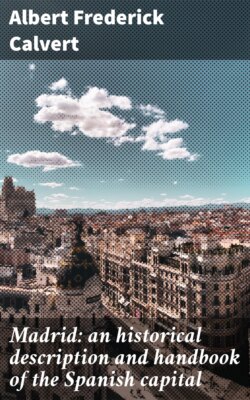Читать книгу Madrid: an historical description and handbook of the Spanish capital - Albert Frederick Calvert - Страница 3
На сайте Литреса книга снята с продажи.
ОглавлениеPREFACE
Table of Contents
Madrid is but a nursling among the cities of Spain. Marius Fulvius laid siege to Toledo nearly two centuries before the birth of Christ, and it is not until a thousand years later that we find the first historical mention of Madrid. London, under the title of Augusta, was one of the most important towns of Britain more than five hundred years before Don Ramiro II. of Leon razed Majerit, as it was then called, in 939. This is the first authoritative reference we have to Madrid. In 1540, Charles V. abandoned the time-honoured capitals of Valladolid, Seville, Zaragoza, and Toledo, to nurse his gout in the brisk, rarefied air of Madrid. In 1560 the city was declared “the only Court” by Philip II., and styled “Imperial y Coronada, muy noble y muy leal”; Ferdinand VII., in 1814, added the words “y muy heroica.”
Despite the flattering and dignified official epithets that have been bestowed upon it, Madrid possesses many natural features which militate against its popularity as a residential centre; but, despite its isolated and elevated position and the treacherousness of its climate, the city has not deserved the strictures that have been passed upon it by captious and prejudiced critics. For Madrid is a city of broad thoroughfares, magnificent public buildings, and handsome houses; and, since it has been rescued from its geographical remoteness by being made the centre of the Spanish railway system, it has become one of the most accessible and prosperous capitals of Europe.
In devoting a volume to an historical and descriptive account of Madrid, I am not only fulfilling a duty which could not be neglected in any serious attempt to make this Spanish Series useful and comprehensive, but I am also inspired with a hope of being able to dissipate many of the erroneous and defamatory impressions that are current with regard to the Spanish capital. I have approached the task from the standpoint of a resident writing for visitors to the city, and if my notes are biassed in favour of my subject, I can only say that I have a sincere liking and admiration for the city, and I have spoken of its people as I have found them. The Spanish metropolis is modern; it is imbued with the principles of modern progress; and while one never ceases to rejoice in the unfaltering, unchanging adherence to an immemorial past, characteristic of Toledo, one may feel an interest, equally keen and appreciative, in the spirit of new Spain which is to be found in Madrid.
Not the least pleasant part of an author’s privilege in penning a preface is the opportunity it affords him of acknowledging the assistance and courtesy he has received in the accomplishment of his task. To Mr W. Gallichan my thanks are due for assistance received in the compilation, and I am also grateful to Señor Don J. Lacoste and Messrs Hauser y Menet for their kindness in permitting me to reproduce many of the illustrations that adorn this little book.
A. F. C.
ILLUSTRATIONS
Table of Contents
